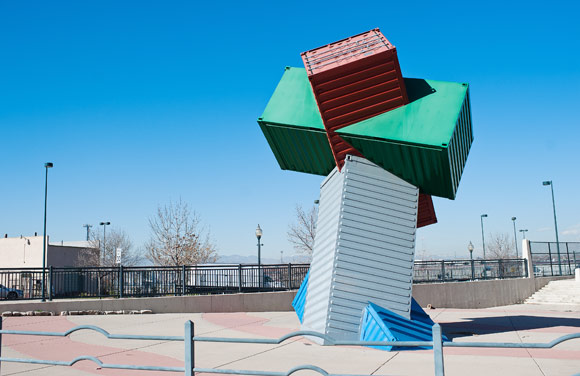Beyond Blucifer and the Blue Bear: Advancing Public Art in Denver
Denver’s “One Percent for Art” law has helped foster a collection of public art that’s the envy of other cities. Where has the policy exceeded expectations — and where has it fallen short?
Denver artist Patrick Marold‘s skill lies, in part, in his ability to capitalize on space, scale and natural elements to transform seemingly cold, industrial materials into a fresh sensory experience.
Consider The Shadow Array, Marold’s $2 million public art commission, which greets visitors who arrive via train to Denver International Airport. The installation was constructed using roughly 250 bulky beetle-kill logs, and fans out on either side of the train tracks. Completed in 2015, Marold characterizes the piece as “a dynamic sculptural composition that utilizes the solar exposure . . . to engage the viewer with land and sky.”
The artist, a Denver native, says his hometown is a “good art town” with a “strong mission and direction.”
Not a great art town?
“Denver tends to latch on to trends in art and design,” Marold says. “Denver is definitely a sports town.”
Marold nonetheless credits his Denver upbringing with helping him understand, as a child, what public art could and should be. He’s especially glad to see that Denver Arts & Venues, the nearly 30-year-old agency that administers the city’s Public Art Program, is finding new ways to bring young artists into the fold, namely through its Urban Arts Fund mural program, which has a call for applications posted through March 20, 2017.
“Denver is great for up and comers, and for diversity,” Marold says. “There are a lot of opportunities.”

Boosting appreciation
In the nearly three decades since Denver Mayor Federico Peña issued his executive order directing all city construction projects over $1 million to set aside 1 percent of their budget for art and design, admirers of what’s become known as the “One Percent for Art” ordinance say it helped foster a place where public art is a welcome thread in the fabric of city life.
Naturally, there also are skeptics. Some say public art by definition is safe and sterile. Others wager that art of any nature is a fiscal luxury unsuited for city dollars.
Mayor Peña had good reason in 1988 to sign Executive Order No. 92, which launched the Denver Public Art Program. The city broke ground on Denver International Airport the following year, and the Colorado Convention Center opened roughly two years later.
The ordinance specifically covers city-funded construction projects in parks, streets and municipal buildings.

“We were in the process of rebuilding Denver,” Peña says during a recent call to the offices of the Colorado Impact Fund, the venture capital firm where the former mayor is now a senior advisor. “We did not want to simply build a bunch of concrete and steel. We wanted to distinguish Denver by making sure these projects had art, design, history and futurism.”
The city was coming out of a recession, he recalls. “Every dollar we spent and saved was critical,” Peña says.
For inspiration, the mayor’s staff looked to cities such as Seattle, which in 1973 became the first in the country to adopt a percent-for-art initiative.
“I think we were able to demonstrate to people that adding design and art to these buildings actually enhanced their value,” he says. “More importantly, it improves the quality of life for people in Denver in ways you cannot measure.”
Peña spent two terms as mayor (from 1983 to 1991) before being called on by former President Bill Clinton to serve as transportation secretary and then energy secretary. Before moving to Washington, D.C., he passed the public art leadership baton to Wellington Webb, who is credited with urging Denver City Council to pass an updated version of the “One Percent for Art” law in 1991.
Today, whenever Peña travels by plane or drops into an event at the Colorado Convention Center, he says he feels “the cumulative effect of the city’s commitment to art and design.”
The hero and the antihero

It follows that Michael Chavez, Denver’s current public art manager, says the most popularized pieces of the city’s public art collection are at each of those locations: the Convention Center’s 40-foot-tall grizzly looky-loo entitled I See What You Mean, by Lawrence Argent, and DIA’s Mustang, the fabled sapphire stallion that killed its maker (artist Luis Jiménez) before its completion, thus earning the piece a number of colorful nicknames including “Blucifer.”
Chavez says these statues are the “hero and antihero” among the more than 300 works in the Denver Public Art Collection. All of the works in the collection are the result of a meticulous selection process in which the city calls for submissions, and each commission is awarded by a project-specific panel.
“Everybody can’t like everything,” says Chavez, who notes that most sizable cities nationwide now has some variety of percent-for-art ordinance. The percentage may be different, and some other towns may incorporate private construction projects in the law, but the spirit of these laws is largely becoming de rigueur.
“We’re bringing these unexpected experiences to people who aren’t seeking them,” Chavez says. “It would be more upsetting to me if we did something and it went unnoticed.”

Giving voice to communities
Budget is the key issue that can restrict cities from passing a percent-for-art-initiative. It follows that many smaller cities must rely on private dollars to create public artwork.
That was the arrangement a few years ago when the Boulder Arts Commission selected $150,000 for a public artwork funded by grant money for the renovation of the Boulder Public Library’s main branch.
“On the one hand, there’s complete flexibility when we find the funding,” says Mandy Vink, Boulder’s public art coordinator. “The art can be anywhere, and it doesn’t have to be reflective of the construction project that’s behind it.”
On the other hand, that approach can alienate the very audience that’s meant to engage with the art: the public.
According to the Daily Camera, the selection committee that reviewed proposals for the Boulder Public Library project received 367 submissions. From those, they selected a work by a pair of Miami artists who wanted to erect story-high red letters that lit up and spelled the word “YES!”
Until, that is, Boulder residents cried foul. Some critics deemed the glowing letters unsuited to Boulder’s picturesque mountain backdrop; others thought it was just too expensive. In the end, city leaders scrapped the project and conceded that Boulder needed more formal and transparent public art administration.
Vink and her colleagues at the Boulder Office of Arts + Culture saw opportunity in the library commission dust-up. They developed a Community Cultural Plan with six distinct community priorities. Boulder City Council adopted the plan in 2015. At the same time, the city also passed a tax that creates a small public art budget for three years, and issued a mandate that the city find a permanent and transparent funding structure.
“It was a great time for us, from the city’s perspective, to say, ‘Our community might need a different introduction to community art,'” says Vink, who cut her teeth working on public art at DIA. Leftover dollars from the failed library commission were funneled into nine smaller, temporary installations.
That project, dubbed Experiments in Public Art, facilitated a visit in September by Austrian artist Markus Dorninger, who used a community-fueled mobile app to create real-time digital animations called Mapping Stories, which were projected on the sides of iconic Boulder buildings.
Vink says such temporary pieces help expand perceptions of public art beyond simply being “some statue that shows up at the completion of a construction project.”

Tech-driven artwork in particular has the benefit of attracting fresh talent to apply for public art commissions.
“Encouraging studio artists to apply for these commissions can be hard,” Vink says. The most common stigma: “Art by committee is just going to bastardize the art.”
Some of this discourse is why Denver art consultant Martha Weidmann is pleased to see that the most recent version of the Denver Public Art Ordinance includes more than a dozen definitions of what public art can be, including light and sound art as well as portable and temporary displays.
“One thing that is clear to me after reading that ordinance is that the city is trying to stay up to date on the definitions of what public art can be,” says Weidmann. Her company, NINE dot ARTS, is enlisted to select artwork for private developers. The firm also has worked with such municipalities as Avon to develop public art programs.
Weidmann acknowledges that the municipal public art program has been “hugely important in Denver’s growth and appreciation of the arts in general.” She also credits the city for “finding spaces where they can make new definitions of what public art is.”
She applauds that updated language in the ordinance because the nature of what constitutes art has evolved significantly since the law was first drafted. Weidmann points to the blush-colored smiley face clouds that artist Stuart Semple released in downtown London at the height of the Great Recession. “I am hoping it might put a smile on a few people’s faces as they go through their day,” Semple told The Telegraph about his floating soap-and-helium creations.

So could Denver become known as the type of city that attracts public art fans in the same way that tourists flock to “The Bean” in Chicago (Cloud Gate by Anish Kapoor) or Robert Indiana’s LOVE in New York City?
“The new world of public art,” Weidmann says, “is public-private partnership.”
For instance, NINE dot ARTS teamed up with the Denver Theatre District, a nonprofit organization funded by digital outdoor advertising, on Terra Firma, a series of urban art installations coming this spring. It will launch with The Blue Trees, which will come to life in April and May when artist Konstantin Dimopoulous douses the trunks and branches of several downtown Denver trees in vivid, water-soluble pigment to make a statement about deforestation.
That also will serve as an example of how art that benefits the public happens as the result of private revenue dollars and the collaboration of several city agencies. “These types of partnerships are one way that [the city] is expanding the parameters of possibility,” Weidmann says.
But for Forrest Morrison, a Denver studio artist who has successfully landed large-dollar private art and design commissions for such venues as The Curtis Hotel, the city’s public art collection is still punctuated by safe, accessible works.
“It’s been a little frustrating trying to transition to public art,” says Morrison, who was recently rejected for a commission at the Denver Zoo. He likens the application process to a job interview. “Unless you have experience doing these bigger projects, it’s hard to get your foot in the door.”

Photos by Kara Pearson Gwinn. Top photo: Forrest Morrison works on a mural for The Curtis Hotel. “I See What You Mean” by Lawrence Argent peers into the Colorado Convention Center. Kevin Curry’s “Face the Sun” is at 41st Avenue and Tennyson Street.
Launched during the 10th annual Denver Arts Week, this story is the third in a four-part series funded by the Bonfils-Stanton Foundation and produced by Confluence Denver and Creative Exchange examining the impact of art and artists on Colorado’s evolving capital city.

[…] IdeaLab is organized by Confluence-Denver and Creative Exchange, and made possible through the generous support of the Bonfils-Stanton Foundation. This program is supported by the Denver Arts & Venues Cultural Partner Program at the McNichols Civic Center Building. Read stories as part of this series on graffiti and development in Denver, artist spaces and displacement, and percent for art programs. […]
Great post. Go Denver public art.